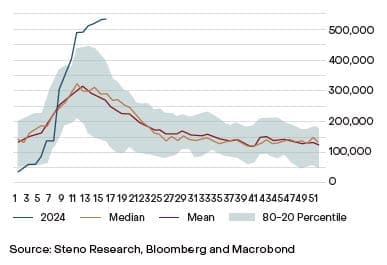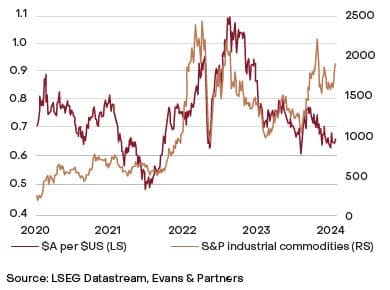


Supercycle a Step Closer
Significant structural imbalances appear to be building the foundations of another supercycle for several commodities where demand and supply remain meaningfully disconnected.
There have been big moves in a range of commodity prices so far in 2024. Some of the factors at play are short term but the bigger story is one of structural demand and supply imbalance for several commodities that will affect prices for a number of years and potentially drive another supercycle. This is not true for all commodities, however, with iron ore and lithium facing their own unique challenges.
Converging trends for copper
Copper is at the centre of most of these trends. The copper price has jumped in the short term due to supply problems. Governments have forced the closure of major mines in Panama and Ecuador based on environmental concerns, there has been drought in Chile and China has been aggressively stockpiling. Demand is also rising because of improvement in the global industrial economy after a two year slump.
There is an even bigger structural story that will play out over the next decade. Copper demand is set to double over that period due mostly to electric vehicles and electrical grid expansion but there is no corresponding increase in supply in the pipeline. Other industrial metals including aluminium, nickel and platinum will be affected by some of the same factors.
There are also structural supply problems. Miners are facing greater environmental regulations and shareholder activism. Ore quality is declining and costs are rising because new discoveries are in more challenging areas. Given the long lead time to bring new projects to market and limited exploration activity in recent years, imbalances are likely to last for some time.
Different factors for different metals
These issues are most problematic for industrial metals and energy. There are different factors at play for iron ore, precious metals and agriculture. Gold is benefitting from China’s decision to add more of the metal to its official reserves. Many agricultural crops are being affected by climate disruption. The outlook for iron ore, however, will be heavily dependent on the resolution of the Chinese property crisis; recent government action is likely to stabilise prices and sales but overall construction is still set to fall materially in coming years.
One major commodity that has recently been moving lower is lithium. China is trying to build domestic production and supply has surged out of Chile. At the same time tariffs imposed on Chinese battery and EV exports by the US and Europe could disrupt end demand.
Our preference is to play this theme through commodity producers. Commodity stocks have not kept pace with commodity prices. There is at least a 20% gap now for gold and metal miners and energy companies. We also expect rising commodity prices to push the Australian dollar higher in the medium term.
Copper futures prices

Chinese Copper Stock levels (data since 2007)
What is China preparing for?

Commodity prices and $A

Tags
Important Disclosures
This document was prepared by Evans and Partners Pty Ltd (ABN 85 125 338 785, AFSL 318075) (“Evans and Partners”). Evans and Partners is a wholly owned subsidiary of E&P Financial Group Limited (ABN 54 609 913 457) (E&P Financial Group) and related bodies corporate.
This communication is not intended to be a research report (as defined in ASIC Regulatory Guides 79 and 264). Any express or implicit opinion or recommendation about a named or readily identifiable investment product is merely a restatement, summary or extract of another research report that has already been broadly distributed. You may obtain a copy of the original research report from your adviser.
The information may contain general advice or is factual information and was prepared without taking into account your objectives, financial situation or needs. Before acting on any advice, you should consider whether the advice is appropriate to you. Seeking professional personal advice is always highly recommended. Where a particular financial product has been referred to, you should obtain a copy of the relevant product disclosure statement or other offer document before making any decision in relation to the financial product. Past performance is not a reliable indicator of future performance.
The information may contain statements, opinions, projections, forecasts and other material (forward looking statements), based on various assumptions. Those assumptions may or may not prove to be correct. Neither E&P Financial Group, its related entities, officers, employees, agents, advisers nor any other person make any representation as to the accuracy or likelihood of fulfilment of the forward looking statements or any of the assumptions upon which they are based. While the information provided is believed to be accurate E&P Financial Group takes no responsibility in reliance upon this information.
The information provided is correct at the time of writing or recording and is subject to change due to changes in legislation. The application and impact of laws can vary widely based on the specific facts involved. Given the changing nature of laws, rules and regulations, there may be delays, omissions or inaccuracies in information contained.
Any taxation information contained in this communication is a general statement and should only be used as a guide. It does not constitute taxation advice and before making any decisions, you should seek professional taxation advice on any taxation matters where applicable.
The Financial Services Guide of Evans and Partners contains important information about the services we offer, how we and our associates are paid, and any potential conflicts of interest that we may have. A copy of the Financial Services Guide can be found at www.eandp.com.au. Please let us know if you would like to receive a hard copy free of charge.
Internship Program - Expression of Interest
Fill out this expression of interest and you will be alerted when applications open later in the year.
Help me find an SMSF accountant
Begin a conversation with an accountant who can help you with your self-managed super fund.
Media Enquiry
Help me find an adviser
Begin a conversation with an adviser who will help you achieve your wealth goals.
Subscribe to insights
Subscribe to get Insights and Ideas about trends shaping markets, industries and the economy delivered to your inbox.
Start a conversation
Reach out and start a conversation with one of our experienced team.
Connect to adviser
Begin a conversation with one of our advisers who will help you achieve your wealth goals.
You can search for an adviser by location or name. Alternatively contact us and we will help you find an adviser to realise your goals.


